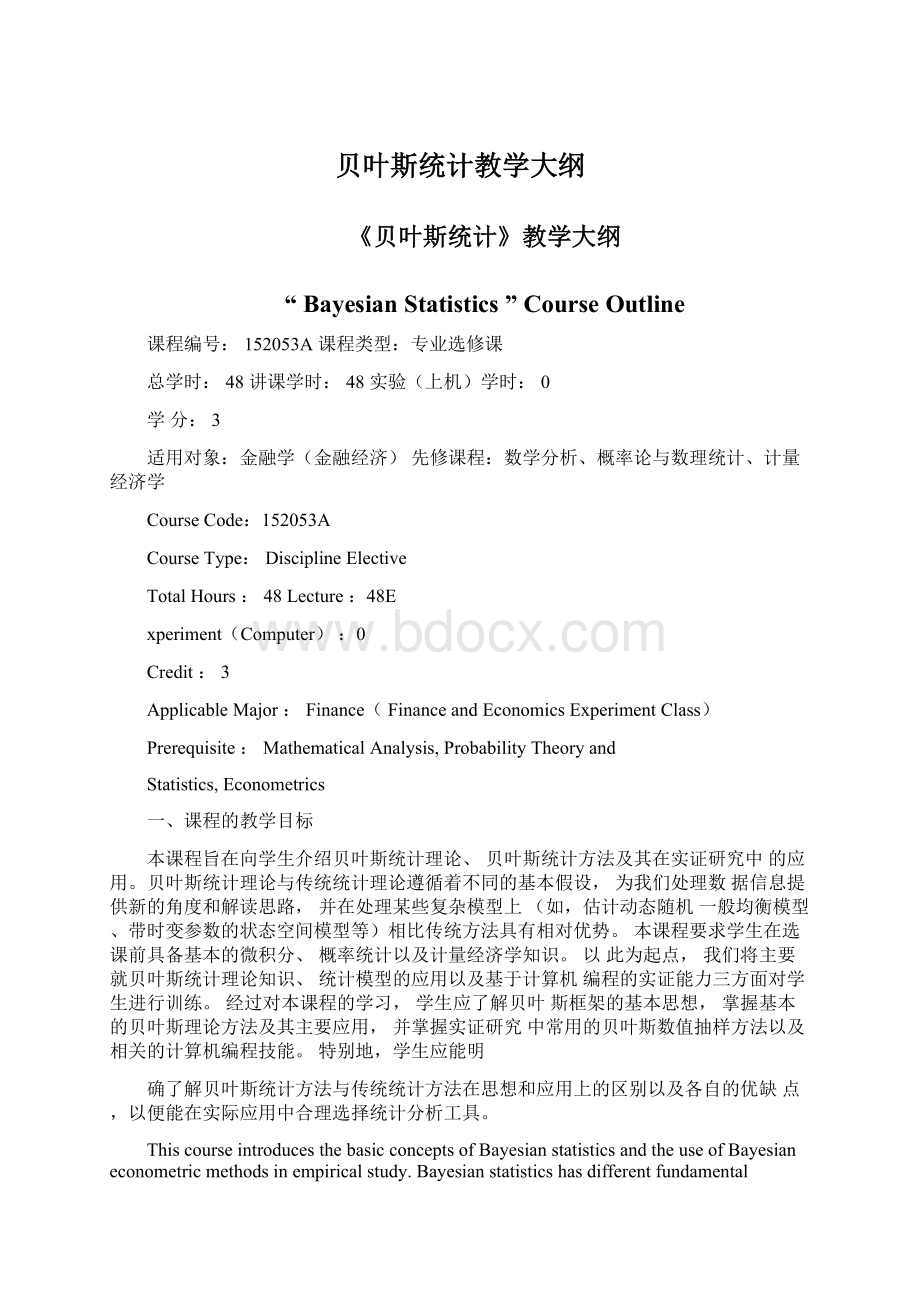贝叶斯统计教学大纲.docx
《贝叶斯统计教学大纲.docx》由会员分享,可在线阅读,更多相关《贝叶斯统计教学大纲.docx(12页珍藏版)》请在冰豆网上搜索。

贝叶斯统计教学大纲
《贝叶斯统计》教学大纲
“BayesianStatistics”CourseOutline
课程编号:
152053A课程类型:
专业选修课
总学时:
48讲课学时:
48实验(上机)学时:
0
学分:
3
适用对象:
金融学(金融经济)先修课程:
数学分析、概率论与数理统计、计量经济学
CourseCode:
152053A
CourseType:
DisciplineElective
TotalHours:
48Lecture:
48E
xperiment(Computer):
0
Credit:
3
ApplicableMajor:
Finance(FinanceandEconomicsExperimentClass)
Prerequisite:
MathematicalAnalysis,ProbabilityTheoryand
Statistics,Econometrics
一、课程的教学目标
本课程旨在向学生介绍贝叶斯统计理论、贝叶斯统计方法及其在实证研究中的应用。
贝叶斯统计理论与传统统计理论遵循着不同的基本假设,为我们处理数据信息提供新的角度和解读思路,并在处理某些复杂模型上(如,估计动态随机一般均衡模型、带时变参数的状态空间模型等)相比传统方法具有相对优势。
本课程要求学生在选课前具备基本的微积分、概率统计以及计量经济学知识。
以此为起点,我们将主要就贝叶斯统计理论知识、统计模型的应用以及基于计算机编程的实证能力三方面对学生进行训练。
经过对本课程的学习,学生应了解贝叶斯框架的基本思想,掌握基本的贝叶斯理论方法及其主要应用,并掌握实证研究中常用的贝叶斯数值抽样方法以及相关的计算机编程技能。
特别地,学生应能明
确了解贝叶斯统计方法与传统统计方法在思想和应用上的区别以及各自的优缺点,以便能在实际应用中合理选择统计分析工具。
ThiscourseintroducesthebasicconceptsofBayesianstatisticsandtheuseofBayesianeconometricmethodsinempiricalstudy.Bayesianstatisticshasdifferentfundamentalassumptionsfromtheclassical(frequentist)framework,providinguswithanalternativewayinanalyzingandinterpretingdatainformation.Bayesianmethodsalsohaverelativeadvantages,andthusarewidelyused,indealingwithcertaincomplicatedmodels(forexample,theestimationofDynamicStochasticGeneralEquilibriummodel,statespacemodelswithtime-varyingparameters,etc.).
Studentsshouldhavehadbasictrainingsoncalculus,probabilitytheoryandstatistics,andpreferablyeconometricspriortothiscourse.ThemajortrainingsofferedinthiscoursefocusonBayesiantheories,Bayesianstatisticalmodelswithapplicationsandcomputationalskillsrequiredforempiricalanalysis.Afterthecourse,studentsshoulddeveloptheirunderstandingonthephilosophyofBayesianframework,understandbasicBayesiantheories,Bayesianestimationmethodsandtheirapplications,andmasterthecomputerskillsforthepracticaluseofBayesianmethods.Specifically,studentsshouldunderstandthedifferencesbetweentheBayesianviewpointandtheclassicalfrequentistperspectiveinordertobeabletochooseappropriateanalyzingtoolsinempiricaluse.
二、教学基本要求
贝叶斯统计学和计量方法在近年得到越来越广泛的关注和应用,主要得益于计算机技术的发展使得贝叶斯数值抽样方法在实际应用中得以实现。
因此,除了对贝叶斯相关理论的讲授,计算机数值方法的介绍与相关实践也是同等重要的。
统计理论的部分,本课程主要涵盖贝叶斯定理以及贝叶斯方法的基本数据分析框架,以及运用贝叶斯方法进行回归模型的估计、预测和模型比较的基本方法。
数值方法部分,主要介绍MarkovChainMonteCarlo后验分布抽样方法(Gibbs
抽样法和Methopolis-Hastings抽样法),以及边缘似然函数和贝叶斯因子的估计方法等。
这两部分的内容应紧密结合并辅以实例分析,以课堂讲授结合计算机演
示的方式进行教学。
另外,贝叶斯方法与传统统计方法的对比也应贯穿课程各章节,以帮助学生了解两种方法的优缺点及适用范围,为实际应用提供指导。
对应课堂内容,课后作业也应强调理论和实践的结合,编程练习应占重要比例。
教师应提供必要的编程软件使用指导,并指导学生根据提供的范例练习运用贝叶斯方法进行数据分析。
课程考核方式及其权重如下:
出勤
10%
作业
20%
期末闭卷考试
30%
课程论文
30%
课程论文宣讲
10%
Thankstothedevelopmentofcomputertechnology,BayesianstatisticsandeconometricshasbecomemorepopularasBayesiancomputationalmethodshavebecomepractical.ComputationalmethodsareasimportantastheoriestoBayesianstatistics,soastothiscourse.
Inthetheoreticalstatisticspart,thiscourseinvolvelecturesonBayesTheorem,thegeneralBayesiananalysisframework,andthegeneralapproachestoestimatemodels,developpredictionsandcomparemodelsintheBayesianway.Intermsofcomputationalmethods,wewillmainlyintroducetheMCMCposteriorsampling(theGibbsSamplingandtheMetropolis-HastingAlgorithm),andtheapproximationtechniqueformarginallikelihoodandtheBayesfactor.Thetwopartsshouldintroducedalongwitheachother.Empiricalandcomputerillustrationsarealsonecessaryforstudentstounderstandtheapproach.Lastbutnottheleast,instructorshouldhavetheBayesianframeworkcomparedwiththeClassical
frequentistframeworkinallaspectswhenappropriateinordertoillustratetheadvantages/disadvantagesofthetwoframeworks,providingstudentswithempiricalinstructions.
Homeworkassignmentsshouldbecomposedofderivationsandcomputerexercises.Propersoftwareinstructionsandexamplesshouldbeprovidedtofacilitatestudents'practiceonBayesiananalysistechniques.
Thegradingweightsareasfollows:
Attendancy
10%
Homework
Assignments
20%
FinalExam(Closed
Book)
30%
TermPaper
30%
TermPaper
Presentations
10%
三、各教学环节学时分配
序号
早节内谷
讲课
实验
其他
合计
1
课程简介及贝叶斯定理
CourseOverviewandBayes
Theorem
2
0
0
2
2
贝叶斯统计理论初步
ElementsofBayesian
Inference
4
0
0
4
3
线性回归模型(假设共轭先
6
0
0
6
验分布)
LinearRegressionModelswithNaturalConjugatePriors
4
线性回归模型(假设其他先
验分布)
LinearRegressionModels
withOtherPriors
9
0
0
9
5
非线性回归模型
NonlinearRegression
6
0
0
6
6
潜在变量模型
ModelswithLatentVariables
6
0
0
6
7
时间序列模型
TimeSeriesModels
6
0
0
6
8
贝叶斯模型比较与模型平均
BayesianModel
ComparisonsandModel
Averaging
6
0
0
6
9
论文宣讲
TermPaperPresentations
3
0
0
3
合计
48
0
0
48
四、教学内容
第一章课程简介及贝叶斯定理
第二节贝叶斯定理
1.贝叶斯定理
教学重点、难点:
贝叶斯定理的涵义并通过实例阐释。
课程考核要求:
掌握贝叶斯定理的涵义,并能运用定理对对简单的事件作出推论。
Chapter1CourseOverviewandBayesTheorem
Section1CourseOverview
Section2BayesTheorem
1.BayesTheorem
2.SimpleApplicationsofBayesTheorem
KeyandDifficultPoints:
thekeyideaofBayesTheorempresentedwithexamples.
EvaluationRequirements:
masterthekeyideaofBayesTheorem,andmakeinferenceswiththetheoreminsimplescenarios.
第二章贝叶斯统计理论初步第一节贝叶斯统计理论的基本要素
1.先验分布与后验分布
2.贝叶斯定理的应用
3.贝叶斯统计与传统统计方法的系统性差别第二节点估计和置信区间
1.点估计
2.最高后验密度区间第三节贝叶斯决策理论第四节模型比较
1.边际似然函数
2.预测密度函数
教学重点、难点:
贝叶斯统计各要素的相互关联,与传统统计方法的根本区
别。
课程考核要求:
掌握贝叶斯统计体系各要素的定义及相互联系,了解贝叶斯统计体系与传统统计学的根本区别,了解贝叶斯统计推断的常见内容。
Chapter2ElementsofBayesianInference
Section1BasicElementsofBayesianStatistics
1.PriorandPosterior
2.HowBayesTheoremisused
3.SystematicDifferencesbetweentheBayesianandFrequentistView
Section2PointEstimationandCredibleSets
1.PointEstimation
2.HighestPosteriorDensityInterval
Section3BayesianDecisionTheory
Section4ModelComparison
1.MarginalLikelihoods
2.PredictiveDensities
KeyandDifficultPoints:
therelationshipsbetweenelementsofBayesianStatistics,thefundamentaldifferencesbetweentheBayesianviewandthefrequantistview.
EvaluationRequirements:
mastertheconceptsoftheelementsofBayesianStatisticsandtherelationshipamongthem,understandthefundamentaldifferencesbetweentheBayesianandfrequentistview,andunderstandthecommoncomponentsofBayesianinferences.
第三章线性回归模型(假设共轭分布)
1.用矩阵表示的线性回归模型
2.似然函数
3.共轭先验分布
4.后验分布
第二节预测
第三节贝叶斯数值计算方法:
蒙特卡罗模拟积分
第三节实证范例教学重点、难点:
后验分布的推导与应用,蒙特卡罗模拟积分。
课程考核要求:
理解共轭先验分布假设下的后验分布的推导,掌握运用后验分布进行实证分析,掌握蒙特卡罗模拟积分方法。
Chapter3LinearRegressionModelswithNaturalConjugatePriorsSection1DerivationofthePosterior
1.TheLinearRegressionModelinMatrixNotation
2.TheLikelihoodFunction
3.TheNaturalConjugatePrior
4.ThePosterior
Section2Prediction
Section3BayesianComputationalMethods:
MonteCarloIntegration
Section4EmpiricalIllustrations
KeyandDifficultPoints:
thederivationoftheposterioranditsapplications,MonteCarloIntegration.
EvaluationRequirements:
understandthederivationoftheposterior,analyzerealdatabasedontheposterior,masterthemethodologyofMonteCarlointegration.
第四章线性回归模型(假设其他先验分布)
1.独立正态-伽玛先验分布
2.后验分布
第二节贝叶斯数值计算方法:
后验分布Gibbs随机抽样法
1.Gibbs随机抽样法
2.马尔可夫链蒙特卡罗收敛判定第三节带限制的线性回归模型
1.后验分布
2.贝叶斯数值计算方法:
重要性随机抽样法
第四节实证范例
教学重点、难点:
Gibbs随机抽样法,重要性随机抽样法。
课程考核要求:
掌握Gibbs随机抽样法和重要性随机抽样法,了解如何根据实际情况对抽样方法做出选择。
Chapter4LinearRegressionModelswithOtherPriors
Section1TheIndependentNormal-GammaPrior
1.TheIndependentNormal-GammaPrior
2.ThePosterior
Section2BayesianComputationalMethods:
GibbsSampling
1.GibbsSampling
2.MCMCConvergenceDiagnostics
Section3LinearRegressionModelswithRestrictions
1.ThePosterior
2.BayesianComputationalMethods:
ImportanceSampling
Section4EmpiricalIllustrations
KeyandDifficultPoints:
Gibbssampling,importancesampling.
EvaluationRequirements:
masterthemethodologyofGibbssamplingandimportancesampling,understandhowtochooseappropriatemethodologygiven
differentscenarios.
第五章非线性回归模型
第一节非线性回归模型
1.模型设定
2.先验分布与后验分布
第二节贝叶斯数值计算方法:
Metropolis-Hasting抽样法
1.一般性步骤
2.独立链MH抽样法
3.随机游走链MH抽样法
4.Metropolis-within-Gibbs抽样法
第三节实证范例
MH
教学重点、难点:
MH抽样法,Metropolis-within-Gibbs抽样法。
课程考核要求:
理解MH抽样法的一般步骤,掌握独立链与随机游走链抽样法,了解Metropolis-within-Gibbs抽样法。
Chapter5NonlinearRegression
Section1NonlinearRegression
1.ModelSetup
2.ThePriorandThePosterior
Section2BayesianComputationalMethods:
Metropolis-HastingAlgorithm
1.TheGeneralAlgorithm
2.TheIndependentChainMHAlgorithm
3.TheRandomWalkChainMHAlgorithm
4.Metropolis-within-Gibbs
Section3EmpiricalIllustrations
KeyandDifficultPoints:
Metropolis-HastingAlgorithm,
Metropolis-within-Gibbs.
EvaluationRequirements:
understandthegeneralalgorithmof
Metropolis-Hasting,mastertheindependencechain/randomwalkchainMHalgorithm,understandthemethodologyofMetropolis-within-Gibbs.
第一节删截线性回归模型第二节Probit模型第三节Tobit模型第四节带混合正态的模型教学重点、难点:
各模型的特点及相对应的数据特点,各模型适用的后验分布抽样方法。
课程考核要求:
理解各模型的特点及相对应的数据特点,了解适用的后验分布抽样方法。
Chapter6ModelswithLatentVariables
Section1CensoredLinearModels
Section2ProbitModels
Section3TobitModels
Section4ModelingwithMixturesofNormals
KeyandDifficultPoints:
featuresoftheabovemodelsandtheircorrespondingdatasets,posteriorsamplingwiththeabovemodels.
EvaluationRequirements:
understandthefeaturesoftheabovemodelsandtheircorrespondingdatasets,understandthemethodologyforposteriorsampling.
第七章时间序列模型
第一节线性时间序列模型
1.常见模型
2.一般性估计方法
第二节状态空间模型
1.一般模型设定
2.Gibbs抽样法
3.MH抽样法教学重点、难点:
状态空间模型的贝叶斯估计法。
课程考核要求:
掌握一般时间序列模型的贝叶斯估计方法,了解状态空间模型及其贝叶斯估计法。
Chapter